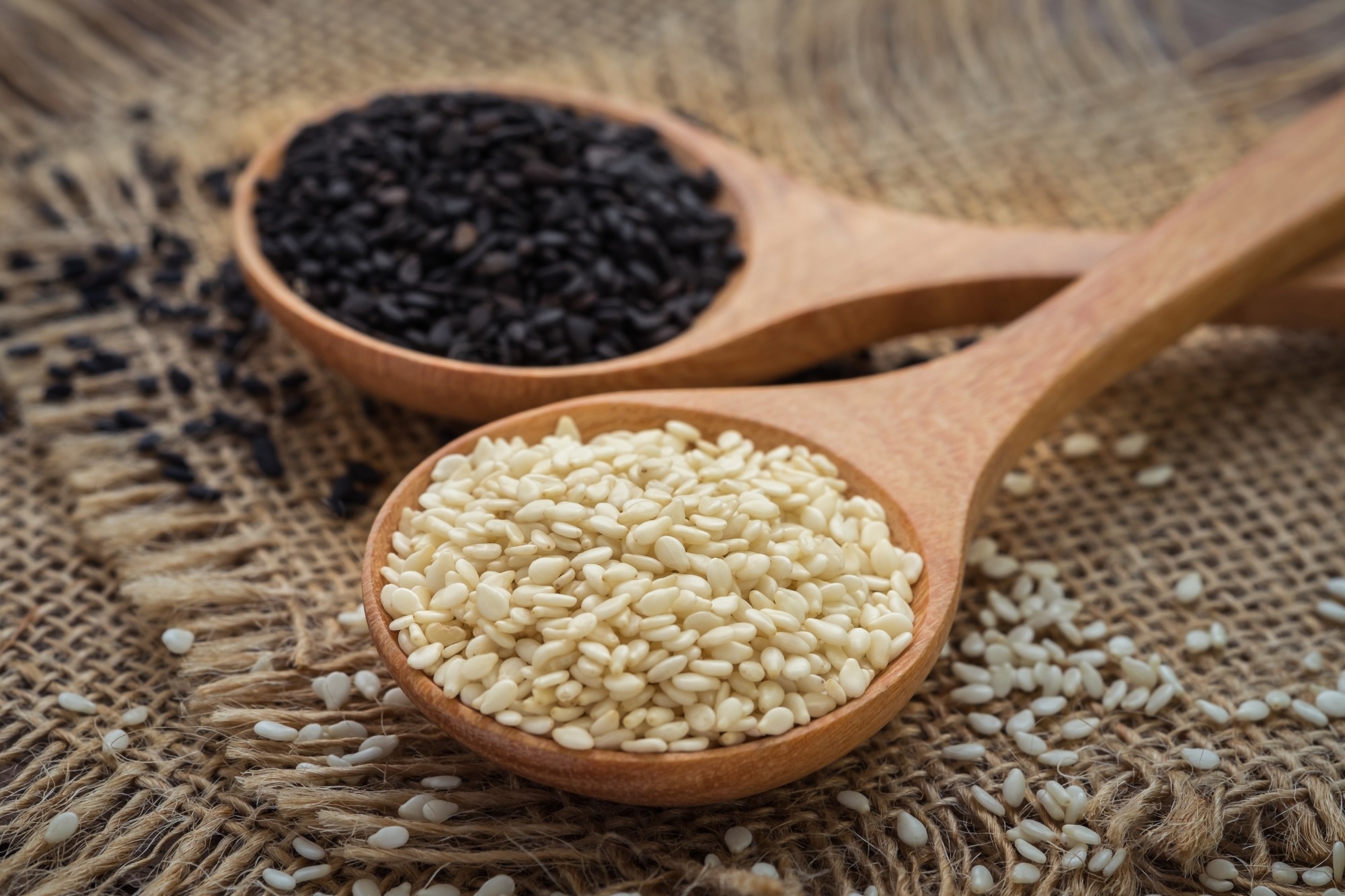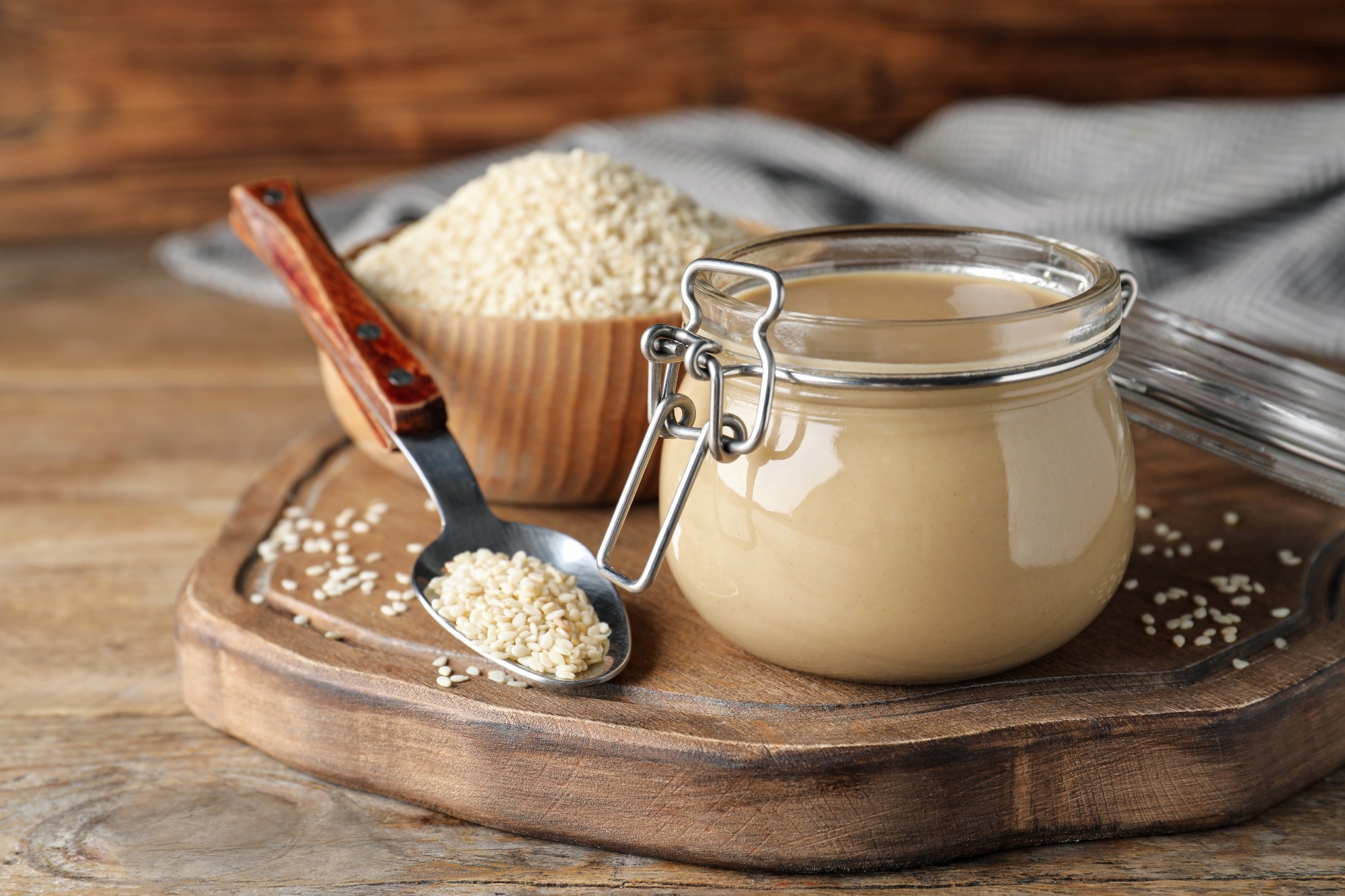Introduction
Nutritional and phytochemical profile
Fatty acid composition
Bioactive compounds
Evidence-based health benefits
Cardiovascular health
Anti-inflammatory and antioxidant activity
Metabolic effects
Liver and renal protection
Neuroprotective and cognitive health
Dermatologic and wound healing applications
Bioavailability and stability
Dietary use and safety profile
Clinical and public health implications
Research limitations and future directions
Conclusions
References
Further reading
From ancient ingredient to modern functional food, sesame oil’s unique blend of lignans, tocopherols, and healthy fats delivers clinically relevant benefits for the heart, metabolism, brain, skin, and more, positioning it as a versatile ally in preventive health.
 Sesame (Sesamum indicum) Image Credit: Amarita / Shutterstock.com
Sesame (Sesamum indicum) Image Credit: Amarita / Shutterstock.com
Introduction
Sesame (Sesamum indicum) seeds are a rich source of bioactive compounds, including lignans (such as sesamin and sesamolin), tocopherols (vitamin E variants), and a high proportion of unsaturated fatty acids. Numerous health-promoting properties are attributed to these constituents.
The potent antioxidant properties of lignans and tocopherols aid in scavenging free radicals and reducing oxidative stress. By lowering serum cholesterol and triglyceride levels, unsaturated fatty acids, primarily oleic and linoleic acids, contribute to creating a favorable lipid profile. These bioactive ingredients also possess anti-inflammatory properties and have been shown to protect the liver, heart, kidneys, and other organ systems, thereby promoting overall cardiovascular and metabolic health .1
Nutritional and phytochemical profile
Fatty acid composition
Oleic and linoleic acids represent about 40% and 44% of sesame seed oil (SSO) content, respectively, whereas saturated fats rarely exceed 20% of the total SSO fat profile. Due to its balanced oleic-to-linoleic ratio, SSO intake can improve blood lipid profiles by increasing high-density lipoprotein (HDL) levels while reducing low-density lipoprotein (LDL) and very-low-density lipoprotein (VLDL) levels.
The omega-3 (ω‑3) and ω‑6 polyunsaturated fatty acids present in SSO yield eicosanoids that modulate immune and inflammatory responses, thereby offering additional protection against atherosclerosis and endothelial dysfunction. Consequently, regular SSO intake is associated with lower total cholesterol and greater vascular elasticity.1,2
Bioactive compounds
The primary lignans present in SSO include sesamin, sesamolin, and sesamol, all of which exhibit antioxidant activity by reducing inflammation and controlling blood pressure levels. SSO is also rich in tocopherols, including γ-tocopherol, which scavenges reactive nitrogen species (RNS) to protect lipids, proteins, and DNA from both oxidative and nitrosative damage. Phytosterols, such as β-sitosterol, also prevent the intestinal absorption of cholesterol and stabilize cell membranes.
Evidence-based health benefits
Cardiovascular health
Sesamin, a sesame lignan, is considered a potent cardiometabolic modulator, as its supplementation has been shown to reduce both systolic and diastolic blood pressure levels. Sesamin also supports endothelium-dependent nitric oxide (NOx) signaling and reduces vasoconstrictor endothelin-1 levels.
In rodents, sesamin supplementation suppresses key intestinal sterol transporters and accelerates hepatic conversion of cholesterol to bile, which reduces LDL levels and raises HDL. Together, these changes reduce vascular inflammation, thereby preventing atherosclerotic plaque formation.1,3
Anti-inflammatory and antioxidant activity
Sesamin and its catechol by‑products scavenge reactive oxygen species (ROS), stimulate antioxidant enzymes such as superoxide dismutase and catalase, as well as maintain consistent sirtuin 1/sirtuin 3-FoxO3a activity. In vitro, sesamin prevents tumor necrosis factor‑alpha (TNF‑α) from activating the pro‑inflammatory nuclear factor kappa B (NF‑κB) pathway, which subsequently reduces interleukin‑6 (IL-6), inducible nitric‑oxide synthase (iNOS), and NOx levels.
Metabolic effects
Eight-week supplementation with sesame oil in type 2 diabetes patients has been shown to reduce fasting glucose and glycated hemoglobin levels, while increasing adiponectin activity. Rodent models have confirmed these effects, as evidenced by improved insulin sensitivity, reduced pancreatic insulin demand, and decreased hepatic glucose-6-phosphatase expression following sesame intake.1.3
Liver and renal protection
In murine fibrosis and adriamycin toxicity models, sesamin normalizes alanine aminotransferase, aspartate aminotransferase, urea nitrogen, and creatinine levels, restores glutathione peroxidase and other detoxification enzymes, as well as suppresses Toll-like receptor 4 and cyclo-oxygenase-2 (COX-2) signaling. Lipopolysaccharide-induced acute kidney injury may also be attenuated through lowered ROS and blocked NF-κB activation, thus demonstrating broad hepatorenal resilience provided by sesamin treatment.1.3
Neuroprotective and cognitive health
Oxidative injury related to ischemic stroke and Alzheimer’s disease is reduced when sesamin scavenges hydrogen peroxide (H₂O₂)-driven ROS, reverses B-cell lymphoma 2 (BCL-2) decline, and limits caspase-mediated apoptosis in human neuroblastoma cells. By preserving mitochondrial Sirtuin 3 function and reducing c-Jun N-terminal kinase (JNK) signaling, sesamine can reduce neuronal death and neuroinflammation, thereby supporting its potential utility for improving cognition.1.3
Top 10 Surprising benefits of Sesame seeds | Sesame health benefits
Dermatologic and wound healing applications
Topical sesame lignan treatment accelerates wound healing and suppresses inflammatory cytokines by inhibiting p38 mitogen-activated protein kinase and NF-κB pathways. In ultraviolet (UV)-challenged fibroblasts and hairless mice, sesamin lowers iNOS, COX-2, and JNK activity, thereby preventing erythema, leukocyte influx, and matrix metalloproteinase-1 (MMP-1)-mediated collagen loss.
Sesamol similarly protects the stratum corneum from UV-induced damage, thereby preserving transepidermal water loss and attenuating hyperpigmentation. Clinical and animal evidence have confirmed these results, with sesamol treatment associated with faster re-epithelialization and significantly reduced scarring in treated wounds.
Bioavailability and stability
Sesame contains bioactive lignans, such as sesamin, which are rapidly absorbed and conjugated after ingestion. Sesamol also exhibits excellent bioavailability, as demonstrated in rodent tracer studies, where its distribution is not affected prior to biliary and urinary excretion.
Notably, the native seed matrix and co-ingested lipids can modulate the uptake efficiency of sesamol. Roasting or frying sesame can improve the stability of its active ingredients, as heat is required for the conversion of sesamolin into sesamol. This thermal conversion leads to the production of Maillard‑derived antioxidants that resist rancidity better than unroasted sesame during cooking cycles.
Industrial trials have demonstrated that incorporating 40-60% SSO with soybean or canola oil reduces peroxide formation and extends the product’s oxidative stability index (OSI) during repetitive frying. Sesame phenolics delay peroxide‑p‑anisidine accumulation, with these effects similar to or superior to those associated with butylated hydroxy‑toluene (BHT) present in sunflower or linseed blends.1,5
Dietary use and safety profile
Sesame can be found in numerous cuisines throughout the world, including tahini, gomadare, toasted seeds on bread, and fragrant oils in Middle Eastern, East Asian, and Mediterranean meals. Routine culinary use suggests that typical servings of sesame are considered safe, with these observations similarly reported in both in vivo and human studies.
Nevertheless, moderation is advised to avoid excess caloric intake or digestive discomfort. Over‑consumption of sesame may also accentuate oxalate‑ and phytate‑mediated mineral losses or promote bleeding in vulnerable individuals due to the abundance of ω‑3 fatty acids.
Importantly, sesame is considered a major priority allergen in many countries. Therefore, individuals with existing seed allergies, those with hypotension, or those prescribed anticoagulants should consult a healthcare professional before incorporating sesame into their regular diet.
 Image Credit: New Africa / Shutterstock.com
Image Credit: New Africa / Shutterstock.com
Research limitations and future directions
Rigorously designed and placebo‑controlled human trials that enroll study participants of varied ages, ethnicities, and health backgrounds are needed to elucidate the health effects of sesame consumption. Current evidence is limited by small sample sizes, a lack of dose-response curves, and sparse pharmacokinetic data, which undermines reproducibility.
To ensure that the results of future studies can be compared across laboratories, it is crucial to standardize both extraction and processing protocols, including cold‑pressing, supercritical carbon dioxide (CO₂), microwave‑assisted, or alkaline methods, as each of these leads to significant differences in lignan and tocopherol content.
Conclusions
The lignans, tocopherols, phytosterols, and unsaturated fatty acids present in sesame oil act synergistically to inhibit oxidative stress, modulate inflammatory reactions, optimize lipid profiles, and improve glycemic control. These mechanisms translate into significant benefits for cardiovascular, metabolic, hepatic, renal, cutaneous, and neurocognitive health, thereby positioning sesame oil as a versatile functional food.
References
- Wei P, Zhao F, Wang Z, Wang Q, Chai X, Hou G, Meng Q. (2022). Sesame (Sesamum indicum L.): A Comprehensive Review of Nutritional Value, Phytochemical Composition, Health Benefits, Development of Food, and Industrial Applications. Nutrients. 14(19). DOI: 10.3390/nu1419407, https://www.mdpi.com/2072-6643/14/19/4079
- Oboulbiga EB, Douamba Z, Compaoré-Sérémé D, Semporé JN, Dabo R, Semde Z, Tapsoba FW B, Hama-Ba F, Songré-Ouattara LT, Parkouda C and Dicko MH (2023) Physicochemical, potential nutritional, antioxidant and health properties of sesame seed oil: a review. Frontiers in Nutrition 10. DOI:10.3389/fnut.2023.1127926, https://www.frontiersin.org/journals/nutrition/articles/10.3389/fnut.2023.1127926/full
- Sarah Dalibalta, Amin F. Majdalawieh, Herak Manjikian, (2020). Health benefits of sesamin on cardiovascular disease and its associated risk factors, Saudi Pharmaceutical Journal 28 (10), 1276-1289. DOI:10.1016/j.jsps.2020.08.018, https://www.sciencedirect.com/science/article/pii/S1319016420301985
- Lin T-Y, Wu P-Y, Hou C-W, Chien T-Y, Chang Q-X, Wen K-C, Lin C-Y, Chiang H-M. (2019) Protective Effects of Sesamin against UVB-Induced Skin Inflammation and Photodamage In Vitro and In Vivo. Biomolecules. 9(9). DOI:10.3390/biom9090479, https://www.mdpi.com/2218-273X/9/9/479
- Fadda, A., Sanna, D., Sakar, E. H., Gharby, S., Mulas, M., Medda, S., Yesilcubuk, N. S., Karaca, A. C., Gozukirmizi, C. K., Lucarini, M., Lombardi-Boccia, G., Diaconeasa, Z., & Durazzo, A. (2022). Innovative and Sustainable Technologies to Enhance the Oxidative Stability of Vegetable Oils. Sustainability. 14(2). DOI:10.3390/su14020849, https://www.mdpi.com/2071-1050/14/2/849
Further Reading
Last Updated: Jul 23, 2025